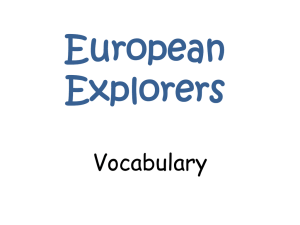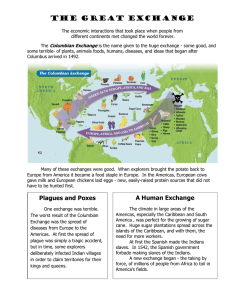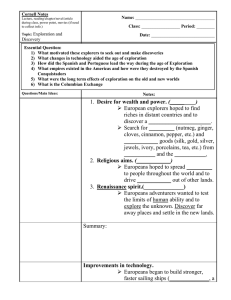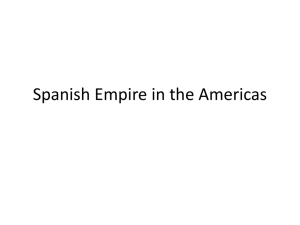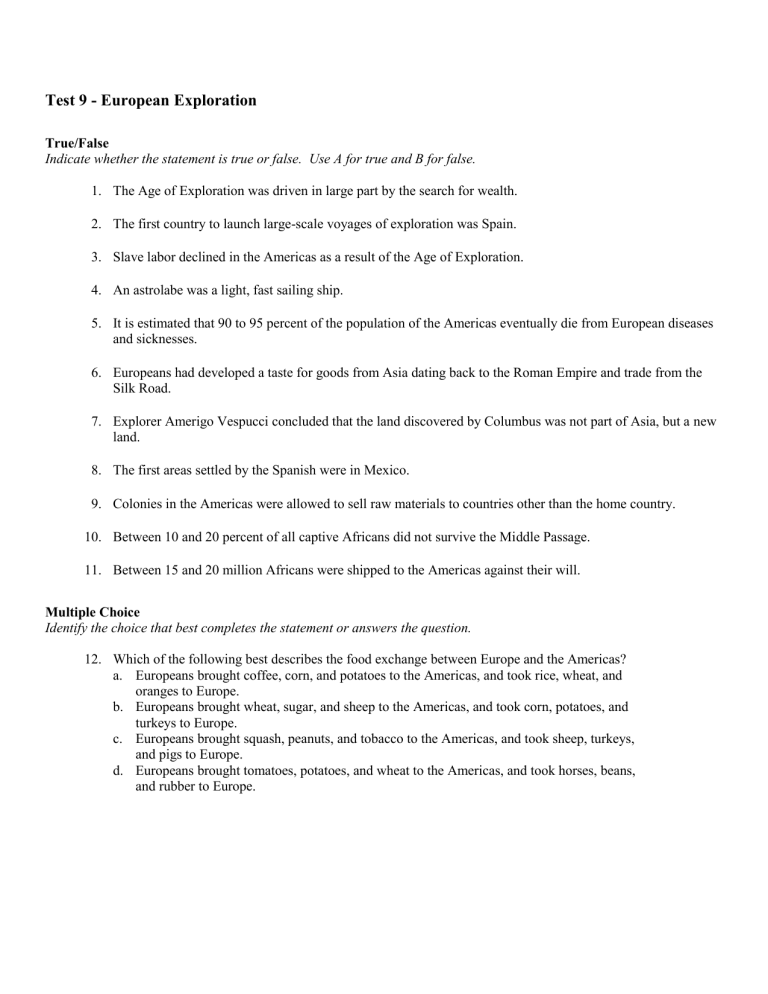
Test 9 - European Exploration True/False Indicate whether the statement is true or false. Use A for true and B for false. 1. The Age of Exploration was driven in large part by the search for wealth. 2. The first country to launch large-scale voyages of exploration was Spain. 3. Slave labor declined in the Americas as a result of the Age of Exploration. 4. An astrolabe was a light, fast sailing ship. 5. It is estimated that 90 to 95 percent of the population of the Americas eventually die from European diseases and sicknesses. 6. Europeans had developed a taste for goods from Asia dating back to the Roman Empire and trade from the Silk Road. 7. Explorer Amerigo Vespucci concluded that the land discovered by Columbus was not part of Asia, but a new land. 8. The first areas settled by the Spanish were in Mexico. 9. Colonies in the Americas were allowed to sell raw materials to countries other than the home country. 10. Between 10 and 20 percent of all captive Africans did not survive the Middle Passage. 11. Between 15 and 20 million Africans were shipped to the Americas against their will. Multiple Choice Identify the choice that best completes the statement or answers the question. 12. Which of the following best describes the food exchange between Europe and the Americas? a. Europeans brought coffee, corn, and potatoes to the Americas, and took rice, wheat, and oranges to Europe. b. Europeans brought wheat, sugar, and sheep to the Americas, and took corn, potatoes, and turkeys to Europe. c. Europeans brought squash, peanuts, and tobacco to the Americas, and took sheep, turkeys, and pigs to Europe. d. Europeans brought tomatoes, potatoes, and wheat to the Americas, and took horses, beans, and rubber to Europe. 13. According to the map titled “The Slave Trade,” where were most slave forts located? a. the Cape of Good Hope c. the Middle Passage b. the west coast of Africa d. Brazil 14. According to the map titled “The Slave Trade,” the British imported approximately how many slaves to their colonies? a. 1.7 million c. 3.6 million b. 2.1 million d. 9 million 15. According to the map titled “The Slave Trade,” the greatest number of African slaves were taken to a. British North America. c. the British West Indies. b. Brazil. d. the French West Indies. “The stench of the hold. . . was so intolerably loathsome, that it was dangerous to remain there for any time. . . The closeness of the place, and the heat of the climate. . . almost suffocated us. . . The shrieks of the women, and the groans of the dying, rendered the whole scene of horror almost inconceivable.” —Olaudah Equiano, The Interesting Narrative of the Life of Olaudah Equiano, 1789 16. In the passage by Olaudah Equiano, he describes a. plantation life. c. a slave ship. b. indentured servitude. d. an encomienda. 17. Which of the following was a conquistador? a. Malinche b. Prince Henry c. Henry Hudson d. Francisco Pizarro 18. Planters in the Americas began to use African slaves for labor because a. Aztecs refused to work on plantations. b. they believed Native Americans were not human. c. disease had killed millions of Native Americans. d. African slaves were less expensive than Native American slaves. 19. What was an effect of the Columbian Exchange? a. Native American diseases destroyed European populations. b. The exchange of foods and animals had a dramatic impact on later societies. c. Llamas began to be used as beasts of burden. d. Triangular trade became less profitable. 20. Which of the following explorers is given the credit as the first to circumnavigate the world? a. Magellan c. da Gama b. Columbus d. Hudson 21. Which of the following best describes the motivation that caused European explorers to find a way to sail to Asia, otherwise known as the “three G’s” a. Gifts, Gold and Glory c. God, Gold and Glory b. God, Glory and Silver d. Gold, God and Gluten 22. How did the Renaissance contribute to the Age of Exploration? a. by emphasizing the importance of converting people to Buddhism b. by awakening a spirit of discovery and innovation in Europe c. by fostering a belief in the importance of working as a group d. by persuading Europeans that the pursuit of wealth was all-important 23. Which of the following was the leader of the Aztecs at the time of Cortes’ arrival? a. Atahualpa c. Hiawatha b. Pizarro d. Moctezuma II 24. Which native American civilization does Pizarro conqueror? a. Inca c. Aztec b. Maya d. all of the above 25. Sailors could calculate their location based on the position of the sun and stars in relation to the horizon with the a. compass. c. caravel. b. astrolabe. d. nautical map. 26. The ultimate goal of the early Portuguese explorers was to a. find a water route around Africa to India. b. discover new lands. c. explore the coast of Africa. d. spread Christianity. 27. The Spanish colonial economy was based largely on a. exports of Native American weaving and pottery. b. tobacco farming. c. the mining of gold and silver. d. fur and fish trading. 28. Which of the following was one result of the Treaty of Tordesillas? a. The Portuguese Empire was larger than the Spanish Empire. b. The Spanish Empire was larger than the Portuguese Empire. c. The British Empire was larger than the Portuguese Empire. d. Spain took control of Brazil. 29. The population of Native Americans in Spanish colonies dropped by more than a. 10 percent. c. 75 percent. b. 30 percent. d. 90 percent. 30. The Spanish used captive Africans as a. domestic servants. b. slaves on Caribbean sugar plantations. c. skilled craft workers. d. ship hands.
